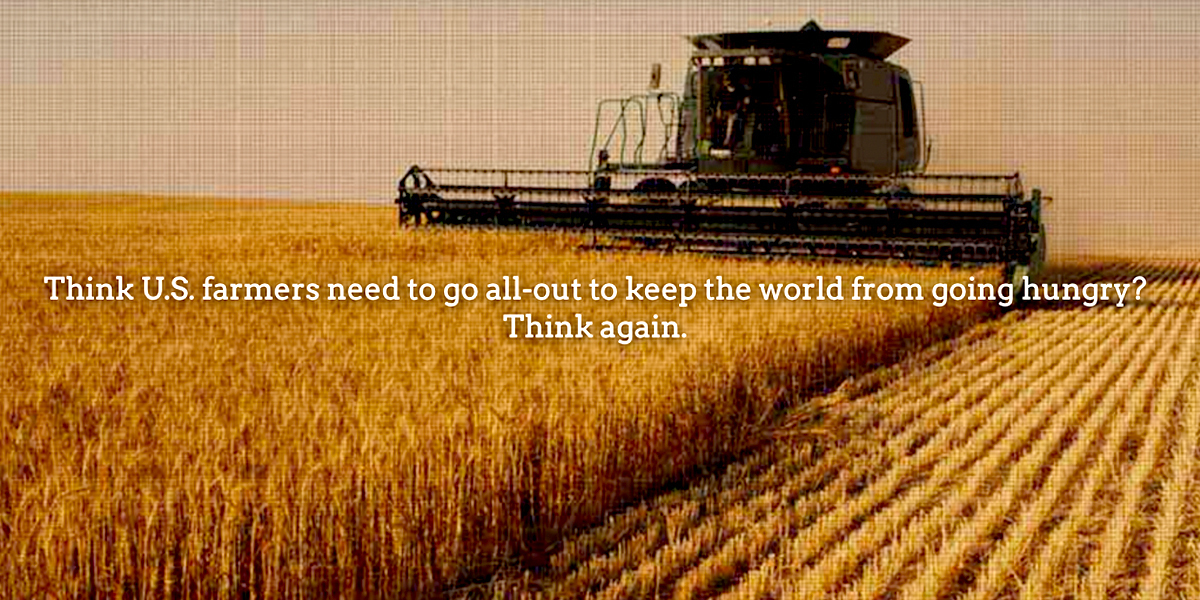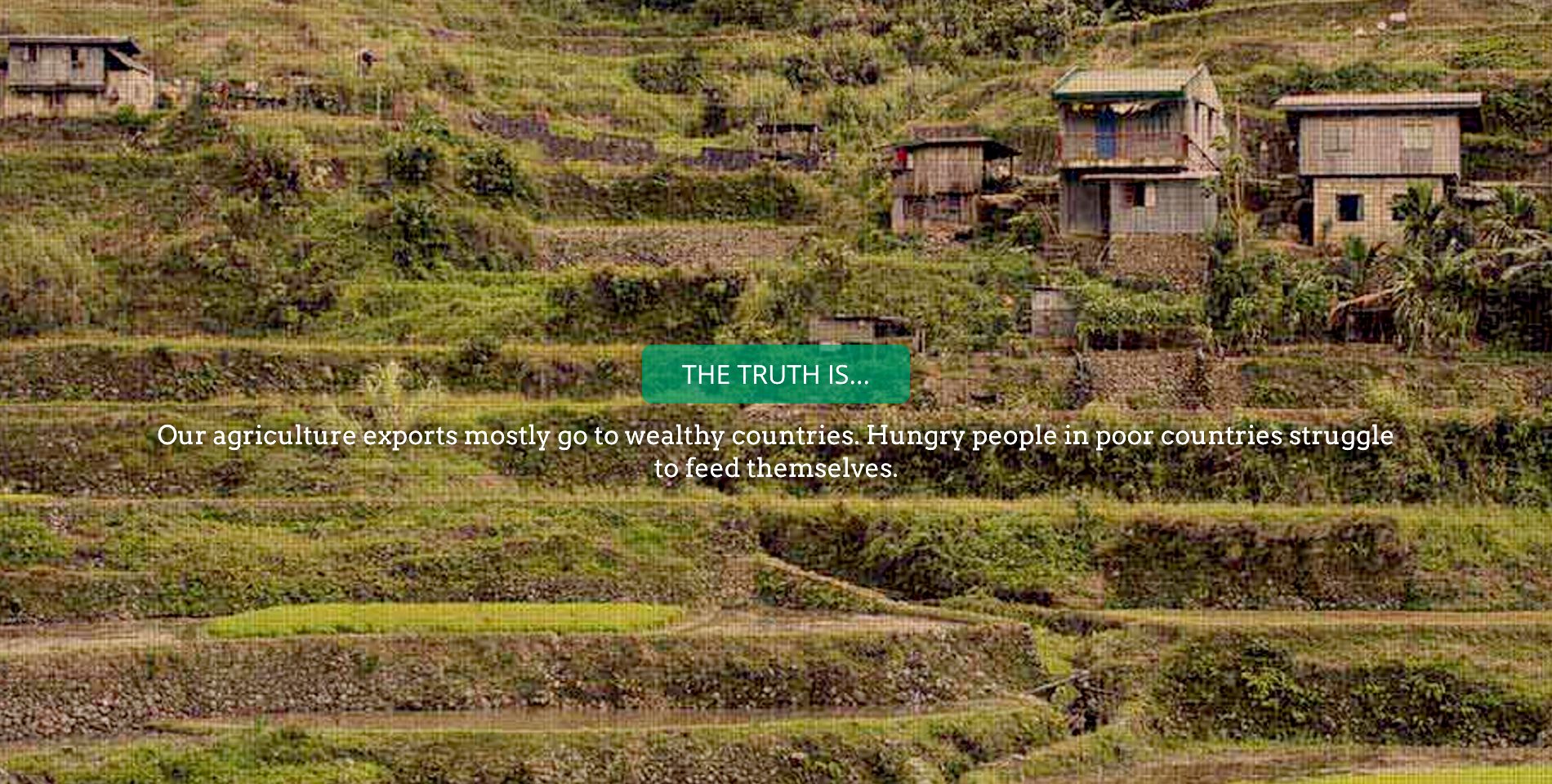

It’s well believed that by the year 2050, 9 billion people will call Earth home. With so many mouths to feed, the United Nations says that world food production must double or else people will go hungry. In order to feed Earth’s swelling population, U.S. agriculture and agribusiness interests, notably Monsanto, have insisted that American farmers aggressively ramp up grain and meat production. Hugh Grant, the CEO of Monsanto, asserts that genetically modified (GMOs) crops are an essential tool to ensure global food security.
However, according to a report, Feeding the World, released today by Environmental Working Group (EWG), the agricultural industry promulgates this “feed the world” mantra as a way to deflect attention from their environmentally destructive practices. In fact, as the authors of the report determined, U.S. agricultural exports are mostly feeding people in wealthy countries that can afford to buy them rather than the most undernourished countries.

“Since 2009 we have continued to hear a lot of agricultural interests claim that American farmers need to increase their production of commodities and meat products in order to ‘feed the world,’ implying that our farmers are feeding hungry people across the globe,” Anne Weir Schechinger, EWG’s senior analyst for economics and author of the report, told EcoWatch. “These interests are deflecting attention from the environmental damage caused by current farming practices, and to discourage any reform from happening to current agriculture policy that could really benefit the environment.”
For the study, Weir Schechinger and co-author Craig Cox, EWG’s senior vice president for agriculture and natural resources, examined where U.S. agricultural exports are going, and what products are being exported to see who the U.S. is actually feeding.
Using trade data, the authors found that 86 percent of American agricultural exports in 2015 went to 20 of the world’s wealthiest and most developed export destinations, including Canada, China, Mexico and the European Union.
As the press release of the report describes:
“Weir Schechinger’s analysis determined that the 20 export destinations that consumed the vast majority of America’s agricultural bounty scored medium, high or very high on a development scale created by the United Nations Development Program. None had large numbers of hungry people. Half of all U.S. exports going to these relatively affluent nations consisted of meat and dairy products, and animal feed.
“Only half of 1 percent of U.S. agricultural exports last year went to 19 nations, including Haiti, Yemen and Ethiopia, that the U.N. Food and Agriculture Organization determined had very high or high undernourishment. The value of U.S. food exports to the top 20 wealthy destinations was 158 times the exports to the 19 most seriously undernourished countries.
“Even more striking, between 2004 and 2013, U.S. exports and food aid combined contributed between only 2 to 4.4 percent of the food supply of those 19 undernourished countries.”
“Poverty is the main reason people go hungry,” an infographic of the report states. “Nearly all the agricultural products the U.S. exports go to countries that can afford to eat more meat and diversify their diets.”

Of course, feeding the world’s growing population is of utmost importance, which is why the EWG report suggests a number of solutions to do so, such as providing the tools and training necessary for communities in poor regions to sustainably grow their own food; significantly increasing international development aid for infrastructure developments to improve roads and build markets to improve access to foods; alleviating poverty and expanding income for women and the very poor; improving nutrition and health education; and ending wars and conflicts.
EcoWatch was able to discuss the report with Weir Schechinger via email. The interview has been edited for length and clarity.
Q. What would you say are the biggest environmental concerns about modern U.S. agriculture?
A. There are numerous environmental and public health damages that are caused by current agricultural practices. There are many water quality issues, like the toxic algal blooms caused by fertilizer run-off from farm fields that we’re seeing in Toledo, Ohio, as well as the Chesapeake Bay and the Gulf of Mexico. Another problem is the contamination of drinking water due to nitrates, like we’re seeing in many places including here in Iowa, as well as pesticide contamination of drinking water throughout the U.S. Additionally, soil erosion is increasing on many farm fields, leading to production losses and clogged waterways. Loss of biodiversity is a major problem that occurs whenever native grasslands or wetlands are brought into agricultural production. We’re also contending with threats to public health from increased antibiotic resistance due to large-scale animal production, since 80 percent of antibiotics in the U.S. are used on livestock.
Q. Some would argue that the reason GMOs have not been adopted in the poorest nations is due to social and political pressures. For instance, many groups in Africa are opposed to GMOs. Many countries in Europe as well as other countries around the world have tight restrictions on GMOs.
A. Bringing GMOs to undernourished countries will not solve hunger. Research has shown that poverty is the main cause of hunger, and growing genetically engineered crops will not directly bring smallholder farmers in undernourished nations out of poverty. Helping smallholders grow more food is a great way to decrease levels of hunger, but GMOs are not a silver bullet to do that. Income generation and economic growth, along with improving access to food through infrastructure development and providing better education especially in health and nutrition can all help decrease hunger.
Q. Would you say that the “feed the world” rationale is a cover for agribusiness companies like Monsanto to drive profits?
A. Agribusinesses do genuinely want to help feed people in hungry countries. Many agribusinesses have programs in undernourished countries that aim to help smallholder farmers increase crop production. But a lot of these same agribusinesses use the “feeding the world” rationale to cover up the environmental damages that are partially due to their products. They also use this rationale to maintain the status quo in farm policy, to deflect any proposals that would change farm policy to lead to less environmental harm.
Q. If an American farmer were to read this study, what would you want his or her main takeaway to be?
A. Exporting grain and meat products is a good business opportunity for American farmers, but that does not carry with it the same moral imperative as solving hunger worldwide. The “feeding the world” argument should not be used to justify the considerable environmental damage that agriculture does to water, soil and public health. Agricultural conservation and pollution prevention practices should be used everywhere they are needed to protect our natural resources and public health.

 233k
233k  41k
41k  Subscribe
Subscribe 